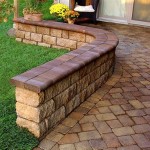How To Reseal a Stamped Concrete Patio
Stamped concrete patios offer an aesthetically pleasing and durable outdoor living space. However, like any outdoor surface exposed to the elements, stamped concrete requires periodic maintenance to preserve its appearance and structural integrity. Resealing is a crucial aspect of this maintenance, protecting the patterned surface from weathering, staining, and abrasion. Understanding the process of resealing stamped concrete is essential for homeowners looking to maintain their investment and enjoy a beautiful patio for years to come.
The purpose of resealing stamped concrete is multifaceted. Primarily, it acts as a barrier against moisture penetration. Concrete, while durable, is porous and susceptible to water absorption. This can lead to freeze-thaw damage in colder climates, causing cracking and surface deterioration. A sealant forms a protective layer that prevents water from entering the concrete pores, safeguarding the structure from this type of damage.
Secondly, a sealant enhances the color and appearance of the stamped concrete. The original color and detailing often fade over time due to exposure to UV rays and general wear. Resealing rejuvenates the surface, bringing back the vibrancy and depth of the stamped pattern and color. Some sealants even offer a glossy or matte finish, allowing homeowners to customize the appearance of their patio.
Finally, resealing provides a layer of protection against staining from spills, chemicals, and environmental factors. Grease, oil, and even common household liquids can penetrate unsealed concrete and leave unsightly stains. A sealant creates a protective barrier that makes cleaning easier and prevents permanent staining, preserving the beauty of the stamped concrete surface.
Assessing the Need for Resealing
Determining when to reseal a stamped concrete patio is crucial for maintaining its optimal condition. There isn't a fixed timeline, as the frequency depends on several factors, including the type of sealant used, the amount of foot traffic, exposure to weather elements, and the quality of the initial installation. However, there are several telltale signs that indicate it's time for a fresh coat of sealant.
One of the primary indicators is the appearance of the concrete itself. If the surface has lost its original sheen and vibrancy, appearing dull or faded, it's likely that the existing sealant has worn down. Similarly, if the color enhancement provided by the sealant is no longer noticeable, resealing is warranted.
Another sign is the presence of stains that are difficult to remove. If you notice that liquids are easily absorbed into the concrete, leaving behind permanent stains, the protective barrier of the sealant has likely been compromised. This means the concrete is vulnerable to further staining and potential damage.
Visual inspection for cracks and surface deterioration is also important. While resealing won't repair existing cracks, it can help prevent further damage by sealing them and preventing water from penetrating deeper into the concrete. If you notice new cracks or an increase in existing hairline cracks, resealing can offer a degree of protection.
A simple water test can also help determine the effectiveness of the current sealant. Pour a small amount of water onto the surface of the concrete. If the water beads up, the sealant is still providing adequate protection. However, if the water is quickly absorbed into the concrete, it's a clear indication that the sealant has worn down and resealing is necessary. Generally, a properly sealed stamped concrete patio should be resealed every 2-3 years depending on the traffic and weathering conditions. High-traffic areas or patios exposed to harsh weather may benefit from more frequent resealing.
Preparing the Surface for Resealing
Proper preparation is essential for a successful resealing job. A poorly prepared surface can result in sealant failure, leading to peeling, bubbling, and an uneven finish. The preparation process involves thorough cleaning, repairing any minor damage, and ensuring the surface is completely dry before applying the sealant.
The first step is to remove all furniture, planters, and other objects from the patio. This will provide unobstructed access to the entire surface and prevent accidental sealant application on unintended items. Once the patio is clear, begin by sweeping away any loose debris such as leaves, dirt, and gravel. A stiff-bristled broom or a leaf blower can be used to effectively remove these materials.
Next, clean the concrete surface thoroughly to remove any dirt, grime, stains, and efflorescence (a white, powdery deposit that forms on concrete). A pressure washer is an effective tool for this task, but it's crucial to use the correct pressure setting to avoid damaging the stamped concrete. A wider fan tip is preferable to a concentrated stream, which can etch the surface. Hold the nozzle at a safe distance and move it in a sweeping motion, ensuring even coverage.
For stubborn stains, such as oil or grease, a degreasing cleaner specifically designed for concrete may be necessary. Apply the cleaner according to the manufacturer's instructions, often involving scrubbing with a brush and rinsing thoroughly with water. For efflorescence or other mineral deposits, a mild acidic cleaner can be used. However, it's crucial to test the cleaner in an inconspicuous area first to ensure it doesn't discolor or damage the concrete.
After cleaning, inspect the patio for any cracks or other damage. Small hairline cracks can often be filled with a concrete crack filler. Apply the filler according to the manufacturer's instructions, ensuring it is level with the surrounding surface. For larger cracks or more significant damage, it may be necessary to consult with a professional concrete contractor. Allow any crack filler to fully cure before proceeding with the resealing process.
Finally, allow the concrete to dry completely before applying the sealant. Moisture trapped beneath the sealant can lead to bubbling and peeling. The drying time will depend on the weather conditions, but it's generally recommended to allow at least 24-48 hours of dry weather. Use a moisture meter to confirm that the concrete is completely dry before proceeding. Aim for a moisture content below 4%.
Applying the Sealant
Choosing the right sealant and applying it correctly are critical steps in the resealing process. There are several types of sealants available, each with its own advantages and disadvantages. The application method also plays a significant role in the final outcome. Before starting, review the sealant manufacturer’s instructions completely.
There are two main types of sealant commonly used for stamped concrete: acrylic sealants and polyurethane sealants. Acrylic sealants are generally more affordable and easier to apply. They provide good UV resistance and enhanced color, but they are less durable than polyurethane sealants and may require more frequent reapplication. Polyurethane sealants offer superior abrasion resistance and durability, making them ideal for high-traffic areas. They are also more resistant to chemicals and staining. However, they are typically more expensive and require more careful application.
Before applying the sealant, ensure the weather conditions are favorable. Avoid applying sealant in direct sunlight or during extreme temperatures. Ideally, the temperature should be between 50°F and 80°F. Also, ensure there is no rain expected for at least 24 hours after application.
There are two primary methods for applying sealant: using a roller or using a sprayer. A roller is a good option for smaller patios and provides more control over the application. Use a high-quality, lint-free roller with a nap length appropriate for the texture of the stamped concrete. A sprayer is more efficient for larger patios and provides a more uniform application. An airless sprayer is recommended for best results.
When applying the sealant, work in small sections and maintain a wet edge to avoid overlap marks. Apply a thin, even coat, avoiding puddles or runs. Overlapping coats can lead to a blotchy appearance. Follow the manufacturer's instructions regarding the number of coats to apply. Typically, two thin coats are recommended, allowing each coat to dry completely before applying the next.
After applying the sealant, allow it to cure fully before allowing foot traffic on the patio. The curing time will vary depending on the type of sealant and the weather conditions. Refer to the manufacturer's instructions for the recommended curing time, which is usually 24-48 hours. Avoid placing furniture or other heavy objects on the patio until the sealant is fully cured.
Applying a non-slip additive to the sealant can enhance safety. Stamped concrete, especially when sealed, can be slippery when wet. These additives can be mixed into the sealant before application, providing increased traction and reducing the risk of slips and falls. Choose an additive that is compatible with the sealant you are using. Some sealants are available with the non-slip additives premixed.

How To Seal Stamped Concrete Sealing A Patio In Downers Grove

How To Clean And Seal Stamped Concrete Sealer Recommendation

How To Clean And Re Seal A Stamped Concrete Patio Everything You Need Know
Resealing Stamped Concrete Tips And Tricks Decor

Should You Reseal Exterior Decorative Concrete Decor

Stamped Concrete Sealing Wow

How To Re Seal A Stained Concrete Patio

How To Re Faded Stamped Concrete Direct Colors

How To Reseal A Stamped Concrete Patio

How To Reseal Concrete When Why Tips From Pros Network
Related Posts








